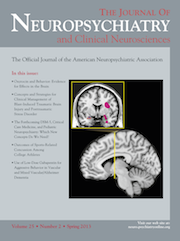Brain Morphology Changes in a Remitted Patient With Late-Onset, Drug-Naïve, Non-Psychotic Major Depressive Disorder After Amisulpride Monotherapy
To the Editor: Amisulpride, a kind of dopamine modulator, has been shown to be effective in treating schizophrenia.1 It is in preliminary use as amisulpride monotherapy for treating major depressive disorder (MDD).
Case Report
“Mrs. W” is a 60-year-old female patient experiencing first-episode, drug-naïve, nonpsychotic MDD symptoms for half a year. No significant other psychiatric diagnosis or physical illness history was noted. After being notified that amisulpride was not routine treatment for MDD, she agreed to sign the informed consent and received amisulpride 200 mg per day for treating MDD. Mild sedation and dry-mouth side effects were mentioned in the initial week of amisulpride. Then the side effects subsided in the following 5 weeks. Her MDD symptoms were significantly improved (Hamilton Rating Scale for Depression [Ham-D] score: 29 to 6] within 6 weeks, especially for depressed mood, ruminations, suicide ideation, appetite, and sleep. Structural brain magnetic resonance imaging (MRI) scans were obtained with the 3T Siemens version scanner housed at the MRI Center, National Yang Ming University. Scans with three-dimensional, fast spoiled, gradient-echo recovery (3D-FSPGR) T1W1 (TR: 25.30 msec; TE: 3.03 msec; slice thickness: 1 mm(no gap);192 slices; matrix: 224×256; field of view: 256 mm; number of excitations: 1) were performed at the first visit and the 6-week visit (Table 1). Structural images were preprocessed with Structural Image Evaluation, using Normalization, of Atrophy (SIENAX) function of FSL (FMRIB Software Library) to calculate single time-point unnormalized gray matter (GM), white matter (WM), and brain volume (BV). The brain morphology change was estimated by SIENA function to calculate percentage of BV change (PBVC; Table 1). GM increased; WM decreased; and BV increased within 6 weeks. The PBVC values of 0.095989650 showed mild increase in BV after amisulpride treatment.
| Gray Matter | White Matter | Brain Volume | |
|---|---|---|---|
| Week 0 | 445,664.72 | 456,047.19 | 901,711.91 |
| Week 6 | 449,364.09 | 455,364.57 | 904,728.66 |
Discussion
In the past, GM reduction with MDD was reported, even after remission with antidepressant treatment.2 Regional GM concentration reduction has also been shown to be associated with attentional bias, depressive psychopathology, and cognitive dysfunction.3 MDD has been reported to be associated with WM abnormalities, such as significantly more subcortical WM lesions, in late-onset depression patients.4 In this late-onset MDD patient, increased GM volume and reduced WM volume were observed after amisulpride treatment. Besides, PBVC value also suggested increase of BV. The patient did not have any cerebrovascular disease, which can exclude the possibility of common vascular effects for WM abnormalities in late-onset MDD. Increases of GM volume and BV of this remitted patient also correspond to Phillips et al.’s finding about increased GM volume and BV of remitted MDD patients.5 GM growth effects might be related to reasons such as synaptic remodeling and neurogenesis6 from the stimulation of neutrophic factors by antipsychotics,7 prevention of oxidative stress or 6-OH-dopamine lesioning, and subsequent increased glial cell proliferation in frontal cortex8 and modulation of glutamate receptor function.9 Apart from these possible reasons, amisulpride’s modulating effects of dopamine D2 receptors might help the dopamine system stabilize and modulate neuronal activity through an inverted-U relationship.10 The WM volume decrease in this patient is very interesting. According to reviews of WM volume in MDD, WM should be decreased in MDD because of decreased oligodendrocyte density, reductions in the expression of genes related to oligodendrocyte function, molecular changes in intercellular cell adhesion molecule (ICAM) expression levels, and suggestion of a possible mechanism of ischemia.11 Konopaske et al. found that antipsychotic exposure decreased oligodendrocyte cell number and related myelination of monkeys,12 which might support volumetric decreases of WM in this case.
1 : Risperidone versus other atypical antipsychotic medications for schizophrenia. Cochrane Database Syst Rev 2000; (3):CD002306Medline, Google Scholar
2 : Depression-related variation in brain morphology over 3 years: effects of stress? Arch Gen Psychiatry 2008; 65:1156–1165Crossref, Medline, Google Scholar
3 : Neural correlates of attention biases of people with major depressive disorder: a voxel-based morphometric study. Psychol Med 2009; 39:1097–1106Crossref, Medline, Google Scholar
4 : Hippocampal volume and subcortical white-matter lesions in late-life depression: comparison of early- and late-onset depression. J Neurol Neurosurg Psychiatry 2007; 78:638–640Crossref, Medline, Google Scholar
5 : Brain-volume increase with sustained remission in patients with treatment-resistant unipolar depression. J Clin Psychiatry 2012; 73:625–631Crossref, Medline, Google Scholar
6 : Antipsychotic drugs and neuroplasticity: insights into the treatment and neurobiology of schizophrenia. Biol Psychiatry 2001; 50:729–742Crossref, Medline, Google Scholar
7 : Olanzapine counteracts reduction of brain-derived neurotrophic factor and TrkB receptors in rat hippocampus produced by haloperidol. Neurosci Lett 2004; 356:135–139Crossref, Medline, Google Scholar
8 : Effects of antipsychotic drugs on neurogenesis in the forebrain of the adult rat. Neuropsychopharmacology 2004; 29:1230–1238Crossref, Medline, Google Scholar
9 : Comparison of the effects of clozapine, risperidone, and olanzapine on ketamine-induced alterations in regional brain metabolism. J Pharmacol Exp Ther 2000; 293:8–14Medline, Google Scholar
10 : The principal features and mechanisms of dopamine modulation in the prefrontal cortex. Prog Neurobiol 2004; 74:1–58Crossref, Medline, Google Scholar
11 : White-matter abnormalities in major depression: evidence from post-mortem, neuroimaging, and genetic studies. J Affect Disord 2011; 132:26–36Crossref, Medline, Google Scholar
12 : Effect of chronic antipsychotic exposure on astrocyte and oligodendrocyte numbers in macaque monkeys. Biol Psychiatry 2008; 63:759–765Crossref, Medline, Google Scholar



